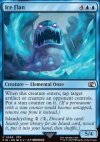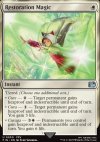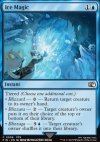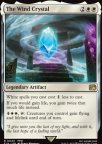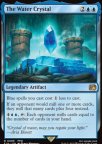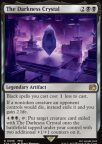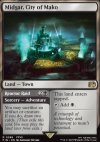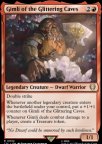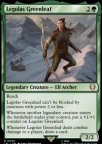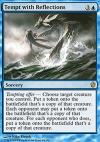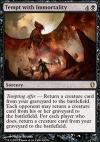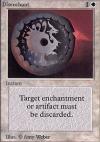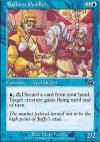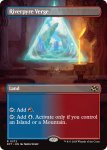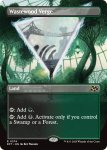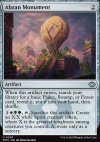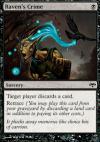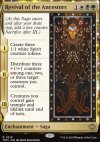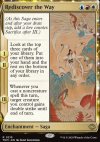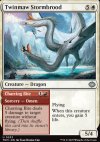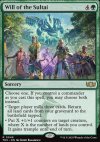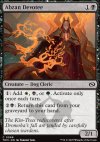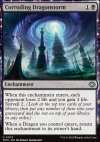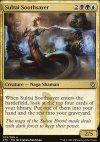|

MV anecdotes
| 971 anecdotes trouvées |   |
Les cinq cartes Cloudbound Moogle, Ice Flan, Malboro, Hill Gigas et Balamb T-Rexaur, de l'édition Final Fantasy, forment un cycle de créatures avec la capacité Recyclage d'un type de terrain de base.
Les quatre cartes Restoration Magic, Ice Magic, Fire Magic et Thunder Magic, de l'édition Final Fantasy, forment un cycle appelé "Magic".
De même, les trois cartes Cloud's Limit Break, Vincent's Limit Break et Tifa's Limit Break, des éditions Final Fantasy et Final Fantasy Commander Decks, forment un cycle appelé "Limit Break" et partagent la même mécanique Tiered.
De même, les trois cartes Cloud's Limit Break, Vincent's Limit Break et Tifa's Limit Break, des éditions Final Fantasy et Final Fantasy Commander Decks, forment un cycle appelé "Limit Break" et partagent la même mécanique Tiered.
Les dix cartes Sharlayan, Nation of Scholars, Treno, Dark City, Vector, Imperial Capital, Gongaga, Reactor Town, Windurst, Federation Center, Insomnia, Crown City, Baron, Airship Kingdom, Gohn, Town of Ruin, Rabanastre, Royal City et Guadosalam, Farplane Gateway, de l'édition Final Fantasy, forment un cycle de terrains.
Les cinq cartes The Wind Crystal, The Water Crystal, The Darkness Crystal, The Fire Crystal et The Earth Crystal, de l'édition Final Fantasy et illustrées par Pablo Mendoza, forment un cycle appelé "Crystal".
Les cinq cartes Ishgard, the Holy See, Jidoor, Aristocratic Capital, Midgar, City of Mako, Lindblum, Industrial Regency et Zanarkand, Ancient Metropolis, de l'édition Final Fantasy, forment un cycle appelé "Adventure Lands" de terrains avec la mécanique d'Aventurier.
La carte Value Town (adventurer) préfigurait l'arrivée de cette mécanique sur ce type de carte.
La carte Value Town (adventurer) préfigurait l'arrivée de cette mécanique sur ce type de carte.
Les deux cartes Gimli of the Glittering Caves et Legolas Greenleaf, de l'édition The Lord of the Rings Commander Decks (decks respectifs Cavaliers du Rohan et Conseil des Elfes), forment une paire de par leur coût de mana, leur première capacité déclenchée identique et leur seconde capacité déclenchée qui offre une récompense en ressources lorsque la créature inflige des blessures de combat à un joueur.
Ces similitudes sont là pour nous rappeler le puissant lien amical, et la rivalité quasi fraternelle, que les deux héros tisseront lors de leur rencontre et de leurs aventures dans le roman du Seigneur des anneaux.
Ces similitudes sont là pour nous rappeler le puissant lien amical, et la rivalité quasi fraternelle, que les deux héros tisseront lors de leur rencontre et de leurs aventures dans le roman du Seigneur des anneaux.
Les cinq cartes Tempt with Glory, Tempt with Reflections, Tempt with Immortality, Tempt with Vengeance et Tempt with Discovery, de l'édition Commander 2013, forment un cycle appelé "Tempt with -".
Les cartes Tempt with Mayhem et Tempt with Bunnies parues ensuite font référence à ce cycle.
Search ~ Texte : "Tempting offer"
Les cartes Tempt with Mayhem et Tempt with Bunnies parues ensuite font référence à ce cycle.
Search ~ Texte : "Tempting offer"
Le type de créature Sortisan, apparu dans le bloc des éditions Mercadian Masques, Nemesis et Prophecy, a vocation de permettre à des créatures de pouvoir convertir n'importe quelle carte en main en l'équivalent d'éphémères/rituels connus de Magic, spécifiques à ces créatures et reproduisant leurs coût et effet respectifs.
Outre les cycles de Sortisans clairement identifiés dans ce bloc ou le bloc Time Spiral (voir cette anecdote, celle-ci et celle-là), il y en a beaucoup d'autres... :
• Devout Witness produit des Disenchant
• Balloon Peddler produit des Jump
• Waterfront Bouncer produit des Unsummon
• Undertaker produit des Raise Dead
• Bog Witch produit des Dark Ritual
• Cackling Witch produit des Howl from Beyond
• Blaster Mage produit des Tunnel
• Hammer Mage produit des Meltdown
• Silverglade Pathfinder produit des Rampant Growth
• Trickster Mage produit des Twiddle
• Divining Witch produit des Demonic Consultation
• Tolarian Sentinel produit des Rescue
• Urborg Syphon-Mage produit des Syphon Soul
• Flowstone Channeler produit des Flowstone Strike
• Jaya Ballard, Task Mage produit des Pyroblast (plus exactement des Red Elemental Blast), Incinerate et Inferno
• Greenseeker produit des Lay of the Land
• Ghost Tactician produit des Scare Tactics ("color-shifted")
• Dreamscape Artist produit des Harrow ("color-shifted")
• Ridged Kusite produit des Guided Strike ("color-shifted")
• Firefright Mage produit des Shriek of Dread ("color-shifted")
• Sophic Centaur produit des Gerrard's Wisdom ("color-shifted")
• ...
Search ~ Créature + Type : Spellshaper
Outre les cycles de Sortisans clairement identifiés dans ce bloc ou le bloc Time Spiral (voir cette anecdote, celle-ci et celle-là), il y en a beaucoup d'autres... :
• Devout Witness produit des Disenchant
• Balloon Peddler produit des Jump
• Waterfront Bouncer produit des Unsummon
• Undertaker produit des Raise Dead
• Bog Witch produit des Dark Ritual
• Cackling Witch produit des Howl from Beyond
• Blaster Mage produit des Tunnel
• Hammer Mage produit des Meltdown
• Silverglade Pathfinder produit des Rampant Growth
• Trickster Mage produit des Twiddle
• Divining Witch produit des Demonic Consultation
• Tolarian Sentinel produit des Rescue
• Urborg Syphon-Mage produit des Syphon Soul
• Flowstone Channeler produit des Flowstone Strike
• Jaya Ballard, Task Mage produit des Pyroblast (plus exactement des Red Elemental Blast), Incinerate et Inferno
• Greenseeker produit des Lay of the Land
• Ghost Tactician produit des Scare Tactics ("color-shifted")
• Dreamscape Artist produit des Harrow ("color-shifted")
• Ridged Kusite produit des Guided Strike ("color-shifted")
• Firefright Mage produit des Shriek of Dread ("color-shifted")
• Sophic Centaur produit des Gerrard's Wisdom ("color-shifted")
• ...
Search ~ Créature + Type : Spellshaper
Pour les illustrations des versions Borderless des cinq cartes Bleachbone Verge, Riverpyre Verge, Wastewood Verge, Sunbillow Verge et Willowrush Verge, de l'édition Aetherdrift, le directeur artistique, Vic Ochoa, a commandé à chacun des illustrateurs du cycle des "Pit Fighter Legends" de l'édition Onslaught (voir cette anecdote) l'illustration du terrain donnant un accès conditionnel à la couleur de mana correspondant à celle de la légende qu'il a illustrée à l'origine.
Source : Donny Caltrider (substack.com/@donnycaltrider), le Feb 01, 2025 a écrit :
[...] you may well remember the Pit Fighter cycle of Onslaught. These five legends were the champions of the set's storyline, [...]
The cycle has now been renewed, given new life in Magic's most recent set, Aetherdrift. Art Director Vic Ochoa commissioned each original artist for the Borderless Verge corresponding to the color of their original legend. It's a beautiful connection more than twenty years apart. [...]
The cycle has now been renewed, given new life in Magic's most recent set, Aetherdrift. Art Director Vic Ochoa commissioned each original artist for the Borderless Verge corresponding to the color of their original legend. It's a beautiful connection more than twenty years apart. [...]
Les cinq cartes Abzan Monument, Jeskai Monument, Sultai Monument, Mardu Monument et Temur Monument, de l'édition Tarkir: Dragonstorm, forment un cycle appelé "Monument" et qui fait référence aux clans de Tarkir, respectivement : Abzan, Jeskai, Sultai, Mardu et Temur (voir cette anecdote) de par leur nom et leur illustration.
Ce cycle est inspiré d'un autre cycle paru dans l'édition Dragons of Tarkir (voir cette anecdote).
Ce cycle est inspiré d'un autre cycle paru dans l'édition Dragons of Tarkir (voir cette anecdote).
Les cartes Phantom Nomad, Phantom Flock, Phantom Centaur, Phantom Nantuko et Phantom Nishoba, de l'édition Judgment, forment un cycle appelé "Phantom" de créatures exclusivement blanches et vertes.
La carte Phantom Wurm parue ensuite fait référence à ce cycle.
La carte Phantom Wurm parue ensuite fait référence à ce cycle.
Les cinq cartes Cenn's Enlistment, Oona's Grace, Raven's Crime, Flame Jab et Monstrify, de l'édition Eventide, forment un cycle d'éphémères/rituels communs avec la capacité Retrace.
Les cinq cartes Kin-Tree Severance, Riverwheel Sweep, Rakshasa's Bargain, Defibrillating Current et Dragonclaw Strike, ainsi que les cinq cartes Reputable Merchant, Monastery Messenger, Gurmag Nightwatch, Reigning Victor et Temur Tawnyback, de l'édition Tarkir: Dragonstorm, forment un cycle d'éphémères/rituels tricolores, ainsi qu'un cycle de créatures avec la même intention, avec un coût de mana composé de manas hybrides monochromes (une couleur unique et deux manas génériques), chacun étant rattaché à un des wedges des clans de Tarkir, respectivement : Abzan, Jeskai, Sultai, Mardu et Temur (voir cette anecdote).
Ils peuvent être joués pour uniquement du mana générique, mais coûtent de moins en moins cher en fonction du nombre des couleurs correspondantes des manas qui sont dépensés pour les lancer.
Ce cycle est inspiré d'un autre cycle paru dans l'édition Shadowmoor (voir cette anecdote).
Source (Monocolor Hybrid Mana)
Ils peuvent être joués pour uniquement du mana générique, mais coûtent de moins en moins cher en fonction du nombre des couleurs correspondantes des manas qui sont dépensés pour les lancer.
Ce cycle est inspiré d'un autre cycle paru dans l'édition Shadowmoor (voir cette anecdote).
Source (Monocolor Hybrid Mana)
Les cinq cartes Skirmish Rhino, Jeskai Brushmaster, Lie in Wait, Bone-Cairn Butcher et Mammoth Bellow, de l'édition Tarkir: Dragonstorm, forment un cycle de sorts tricolores peu communs, soutenant chacun un archétype de formats limités et rattachés aux wedges des clans de Tarkir, respectivement : Abzan, Jeskai, Sultai, Mardu et Temur (voir cette anecdote).
Source ("Draft, as an example, had a big influence on the uncommon gold cards that model Draft archetypes")
Source ("Draft, as an example, had a big influence on the uncommon gold cards that model Draft archetypes")
Les cinq cartes Revival of the Ancestors, Rediscover the Way, Awaken the Honored Dead, Thunder of Unity et Roar of Endless Song, de l'édition Tarkir: Dragonstorm, forment un cycle de Sagas tricolores, chacune étant rattachée à un des wedges des clans de Tarkir, respectivement : Abzan, Jeskai, Sultai, Mardu et Temur (voir cette anecdote).
Les cinq cartes Armament Dragon, Jeskai Shrinekeeper, Kheru Goldkeeper, Sonic Shrieker et Karakyk Guardian, de l'édition Tarkir: Dragonstorm, forment un cycle de dragons tricolores, chacun étant rattaché à un des wedges des clans de Tarkir, respectivement : Abzan, Jeskai, Sultai, Mardu et Temur (voir cette anecdote).
Source ("Uncommon [...] A cycle of three-color Dragons")
Source ("Uncommon [...] A cycle of three-color Dragons")
Les cinq cartes Twinmaw Stormbrood, Whirlwing Stormbrood, Purging Stormbrood, Runescale Stormbrood et Disruptive Stormbrood, de l'édition Tarkir: Dragonstorm, forment un cycle appelé "Stormbrood" de dragons, chacun possédant un Omen d'une couleur ennemie.
Source ("There are two cycles of Dragons with Omen spells, one at common where the Dragons are the same color as the Omen spell and one at uncommon on monocolor Dragons with an Omen spell of the Dragon's enemy color. [...] The two-color cards in a wedge set want to be enemy-color cards, as that's what is supported in a wedge-focused Limited environment. Players can start with an enemy-color pair, allowing them to move into one of two three-color wedge factions. If you take an ally-color pair, that card can only go in one wedge. [...] Uncommon [...] A cycle of monocolor Dragons with an enemy-color Omen spell")
Source ("There are two cycles of Dragons with Omen spells, one at common where the Dragons are the same color as the Omen spell and one at uncommon on monocolor Dragons with an Omen spell of the Dragon's enemy color. [...] The two-color cards in a wedge set want to be enemy-color cards, as that's what is supported in a wedge-focused Limited environment. Players can start with an enemy-color pair, allowing them to move into one of two three-color wedge factions. If you take an ally-color pair, that card can only go in one wedge. [...] Uncommon [...] A cycle of monocolor Dragons with an enemy-color Omen spell")
Les cinq cartes Will of the Abzan, Will of the Jeskai, Will of the Sultai, Will of the Mardu et Will of the Temur, de l'édition Tarkir: Dragonstorm Commander Decks, forment un cycle appelé "Will" d'éphémères/rituels, chacun étant rattaché à un des clans de Tarkir, respectivement : Abzan, Jeskai, Sultai, Mardu et Temur (voir cette anecdote).
Ce cycle est inspiré d'un autre cycle paru dans l'édition Commander Legends (voir cette anecdote).
Ce cycle est inspiré d'un autre cycle paru dans l'édition Commander Legends (voir cette anecdote).
Les cinq cartes Great Arashin City, Cori Mountain Monastery, Kishla Village, Dalkovan Encampment et Mistrise Village, de l'édition Tarkir: Dragonstorm, forment un cycle de terrains rattachés aux wedges des clans de Tarkir, respectivement : Abzan, Jeskai, Sultai, Mardu et Temur (voir cette anecdote).
Les cinq cartes Abzan Devotee, Jeskai Devotee, Sultai Devotee, Mardu Devotee et Temur Devotee, de l'édition Tarkir: Dragonstorm, forment un cycle appelé "Devotee" de créatures avec une capacité de mana dont les couleurs sont rattachées aux wedges des clans de Tarkir, respectivement : Abzan, Jeskai, Sultai, Mardu et Temur (voir cette anecdote).
Source (The Common Devotee Cycle - "The goal of the Devotees is to help your three-color deck when you're missing one of your colors without making it too easy to splash a fourth color. Also, Set Design was interested in finding ways to provide mana that played to the board, meaning they helped you advance toward winning the game rather than taking a turn off to play a mana source. [...] After trying various things, the Set Design team discovered that once-per-turn color washing (turning one color of mana into another) did the best job. [...]")
Source (The Common Devotee Cycle - "The goal of the Devotees is to help your three-color deck when you're missing one of your colors without making it too easy to splash a fourth color. Also, Set Design was interested in finding ways to provide mana that played to the board, meaning they helped you advance toward winning the game rather than taking a turn off to play a mana source. [...] After trying various things, the Set Design team discovered that once-per-turn color washing (turning one color of mana into another) did the best job. [...]")
Les cinq cartes Teeming Dragonstorm, Roiling Dragonstorm, Corroding Dragonstorm, Breaching Dragonstorm et Encroaching Dragonstorm, de l'édition Tarkir: Dragonstorm, forment un cycle appelé "Dragonstorm".
Ce cycle est inspiré d'un autre cycle paru dans l'édition Amonkhet (voir cette anecdote).
Source 1 ("We knew that the dragonstorms were going to play an important role in the set's story [...], so we wanted to use them to enable Dragon typal decks. [...] Set Design would end up changing these to enchantment cards that mimicked the Trial cycle of enchantments from Amonkhet. [...]") - Source 2 (The Uncommon Dragonstorm Cycle)
Ce cycle est inspiré d'un autre cycle paru dans l'édition Amonkhet (voir cette anecdote).
Source 1 ("We knew that the dragonstorms were going to play an important role in the set's story [...], so we wanted to use them to enable Dragon typal decks. [...] Set Design would end up changing these to enchantment cards that mimicked the Trial cycle of enchantments from Amonkhet. [...]") - Source 2 (The Uncommon Dragonstorm Cycle)
Les cinq cartes Barrensteppe Siege, Frostcliff Siege, Hollowmurk Siege, Windcrag Siege et Glacierwood Siege, de l'édition Tarkir: Dragonstorm, forment un cycle appelé "- Siege".
Les mots d'ancrage associés à chacun des modes des cartes correspondent aux deux clans de Tarkir dont on peut obtenir le wedge correspondant en ajoutant une troisième couleur qui n'est pas l'alliée commune des deux couleurs du coût de mana (sinon on obtiendrait un éclat), à savoir : Abzan, Jeskai, Sultai, Mardu et Temur (voir cette anecdote).
Ce cycle est inspiré d'un autre cycle paru dans l'édition Fate Reforged (voir cette anecdote).
Source ("The two-color cards in a wedge set want to be enemy-color cards, as that's what is supported in a wedge-focused Limited environment. Players can start with an enemy-color pair, allowing them to move into one of two three-color wedge factions. If you take an ally-color pair, that card can only go in one wedge.")
Les mots d'ancrage associés à chacun des modes des cartes correspondent aux deux clans de Tarkir dont on peut obtenir le wedge correspondant en ajoutant une troisième couleur qui n'est pas l'alliée commune des deux couleurs du coût de mana (sinon on obtiendrait un éclat), à savoir : Abzan, Jeskai, Sultai, Mardu et Temur (voir cette anecdote).
Ce cycle est inspiré d'un autre cycle paru dans l'édition Fate Reforged (voir cette anecdote).
Source ("The two-color cards in a wedge set want to be enemy-color cards, as that's what is supported in a wedge-focused Limited environment. Players can start with an enemy-color pair, allowing them to move into one of two three-color wedge factions. If you take an ally-color pair, that card can only go in one wedge.")
Les cinq cartes Betor, Kin to All, Shiko, Paragon of the Way, Teval, Arbiter of Virtue, Neriv, Heart of the Storm et Ureni, the Song Unending, de l'édition Tarkir: Dragonstorm, ainsi que les cinq cartes Betor, Ancestor's Voice, Shiko and Narset, Unified, Teval, the Balanced Scale, Neriv, Crackling Vanguard et Ureni of the Unwritten, de l'édition Tarkir: Dragonstorm Commander Decks, forment un cycle de dragons esprits légendaires, chacun étant rattaché à un des wedges des clans de Tarkir, respectivement : Abzan, Jeskai, Sultai, Mardu et Temur (voir cette anecdote).
Source ("The two-color cards in a wedge set want to be enemy-color cards, as that's what is supported in a wedge-focused Limited environment. [...] That meant if we put dragonlords in the set, they would have to either be monocolor or three-color creatures. [...] The Creative team decided they would rather create new three-color Dragons and five Spirit Dragons that help the clans. [...] A mythic rare cycle of legendary three-color Spirit Dragons")
Source ("The two-color cards in a wedge set want to be enemy-color cards, as that's what is supported in a wedge-focused Limited environment. [...] That meant if we put dragonlords in the set, they would have to either be monocolor or three-color creatures. [...] The Creative team decided they would rather create new three-color Dragons and five Spirit Dragons that help the clans. [...] A mythic rare cycle of legendary three-color Spirit Dragons")
Les cinq cartes Armament Corps, Warden of the Eye, Sultai Soothsayer, Mardu Roughrider et Bear's Companion, de l'édition Khans of Tarkir, forment un cycle de créatures tricolores peu communes, soutenant chacune un archétype de formats limités et rattachées aux wedges des clans de Tarkir, respectivement : Abzan, Jeskai, Sultai, Mardu et Temur (voir cette anecdote).
Source ("Draft, as an example, had a big influence on the uncommon gold cards that model Draft archetypes")
Source ("Draft, as an example, had a big influence on the uncommon gold cards that model Draft archetypes")
| 971 anecdotes trouvées |   |






 Avatar: the Last Airbender
Avatar: the Last Airbender Spider-Man / Omenpaths
Spider-Man / Omenpaths Edge of Eternities
Edge of Eternities Final Fantasy
Final Fantasy Tarkir: Dragonstorm
Tarkir: Dragonstorm Aetherdrift
Aetherdrift Foundations
Foundations
